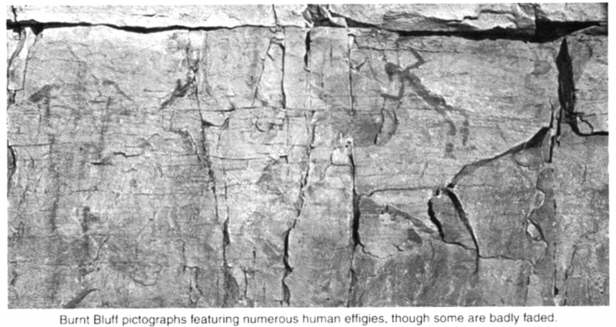|
BURNT BLUFF CAVES AND PICTOGRAPHS
|
Don and Noreen Gustafson
|
| Central States Archaeological Societies 2000
October Journal |
Cadillac, Michigan |

In the summer of 1969 our family made a trip to Delta County in the upper peninsula of Michigan
to see the pictographs and caves of Burnt Bluff. This site was located on private property, and the pictographs
appear at the base of a 140 foot limestone cliff on Big Bay De Noc of Lake Michigan.
The pictographs of Burnt Buff are a unique Michigan feature. There were thirteen much faded
paintings, ranging in height from six inches to two feet. Four of these paintings are clearly evident in or near
Spider Cave, and three others are too eroded to record. Six additional pictographs can be found a quarter mile
to the north and are scattered horizontally over fifty feet of the cliff's face.

When the water level of the Great Lakes is high, they can only be viewed by boat and appear
at eye level. While we were there, the lake level was low and we were able to descend a stairway down the cliff
and view them standing on the rocky shore. Today they would be high and dry due to very low water levels of the
Great Lakes. At the time we visited these features were a mere eight feet above the water level, and the caves
were ten to fifteen feet up the cliff face.
The best known of these painted features is the "Big Man," a reddish human shape.
Standing two feet high, it is the largest of the Burnt Buff paintings . The "Spider Man" pictograph depicts
a human figure with a trapezoid or ovate body partially enclosed by two circular lines extending from a spider-like
creature at the base of its feet. The "Spider Man" colors vary from red-violet to blue-violet. Sadly,
some of these ancient features were damaged by someone in an apparent attempt to chisel them from the cliff face. Little
is known about the people who created this rock art or the purpose it served. Since the subjective designs and
figures are not standardized and cannot be deciphered, they remain a mystery form of rock writing. They were probably
produced as personal or group ritual and the significance of the art was in the image itself or in the act of producing
it. 
The paintings were most likely done using colorful mineral dyes mixed with grease and binders
made from fish roe, the hooves and or skins of a variety of animals. This is evident in both their clarity and
motif. The vegetable based dyes oxidize and fade much faster than mineral dyes and are lost.
In 1963 and again in 1965 the University of Michigan archaeologists studied the caves and shelters
of the precipitous Burnt Bluff. They excavated two of the caves, Spider Cave, and B-95.
Over 100 projectile points were discovered in Spider Cave, all with fractured tips, suggesting
they were shot or thrown into the cave. These points were all Middle Woodland in style (300 BC to 800 AD). A marine
shell disc and several toggle-head harpoons were also found. The absence of hearth pottery or food refuse and the
lack of utilitarian artifacts such as drills, scrapers, and choppers suggest the cave was used for religious or
magical practices.
Cave B-95 produced only two projectile points: one Middle Woodland and an un-typable point.
One ground stone object, perhaps a net sinker weight, was found along with a number of items not normally found
on Michigan sites. Included were pointed wooden sticks, a polished bone awl and fragments of cedar bark cordage
and fabric. Several hearths were found with faunal remains consisting primarily of birds and fish. Charcoal from
one of the hearths was radio-carbon dated at 375AD (+- 130). Remains of seven people were also found in this cave,
most of which were sub-adults.
Cultural material from the caves can be assigned to the Lake Forest Middle Woodland era.
Unfortunately, there is no way of associating the cave occupants with the pictographs, and since
no method of dating the paintings/pictographs exists, their age remains a mystery.
REFERENCE
Fitting, James
Great Lakes Informant, Michigan History Division of the
Department of State Archaeology of Michigan.
|




